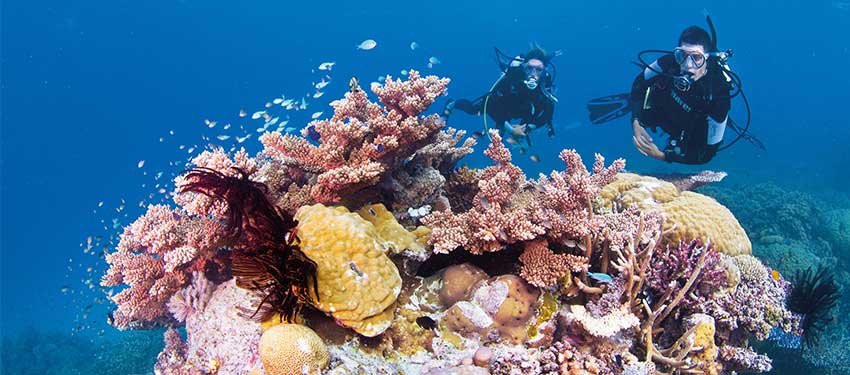Five Tips for Snorkelling on the Great Barrier Reef
It’s no secret that the Great Barrier Reef is the most popular location in Australia amongst snorkelling and scuba diving enthusiasts. This amazing natural wonder of the world is home to an almost unlimited array of fascinating aquatic creatures, stunning coral formations and crystal blue ocean water. Of course, the best way to see this hidden paradise is to dive in and view it from below the surface, but if you’ve never done so before, the experience can be daunting.
If your first experience of breathing through a snorkel or scuba is (or was) akin to trying to gulp large lungful’s of air through a straw, then you’re not alone. Most people find the action of breathing underwater extremely uncomfortable, and so we should – it’s completely opposite to our natural instincts to breathe while submerged, so your mind fights it. There are a number of steps you can take to make your snorkelling or scuba diving experience more comfortable though, and in this article, we will look at the snorkelling tips, with a later article exploring tips for scuba diving. So, read through these tips, breathe freely and let the wonder of the Great Barrier Reef show you how much your perseverance can reward you.
Snorkelling Tips
Use only good equipment – Whether you’re renting or buying your snorkelling equipment, try to obtain a good quality mask and snorkel, as it will make so much difference to your overall experience. Your mask should fit your face comfortably and just tight enough so as not to leak. Masks that are too tight will actually cause leaking, among other things (headache!). A well-fitting mask will generally adhere to your face with a gentle push, while a snorkel should feel comfortable in your mouth.
The use of a dry snorkel (a type of snorkel with a valve that closes when submerged in water) will prevent you from getting water in your mouth or inhaling it, making the snorkelling experience a comfortable one. Similarly, well-fitting fins are essential. There’s nothing worse than tight, uncomfortable fins and these can mar your snorkelling experience significantly. Fins that are too loose can fall off and be lost! Fins are considered an essential part of your safety equipment, as they significantly save energy and can get you out of a dangerous situation fast.
Learn how to de-fog your mask – Just like water in your mask, a foggy mask can impair your vision and make an exciting underwater adventure feel like an annoying, blurry pain. For a good comprehensive tutorial on how to de-fog your snorkel mask, visit this site http://www.dtmag.com/Stories/Dive%20Equipment/03-03-scuba_skills.htm and don’t forget to de-fog new equipment.
Practice makes perfect – Before jumping in the water, try your equipment on at home (if purchased) to double check everything is comfortable. Next, do your first ‘dive’ in safe, shallow water – even a bath or sink is ok – so that you can get the feel of using your gear. If the first experience is distressing, just try to relax and avoid going out to your dive location until you are completely comfortable using your equipment. When you de eventually decide to try deeper water, stay in a safe location while you practice using your fins, expelling water from your snorkel and adjusting your mask on site. Knowing how to do these things will save you a lot of trouble down the track.
First Snorkelling experience – It’s always a good idea to attempt your first dive in either shallow water or at a beach so that you can stand on solid ground if needed. Whether you are joining a snorkelling tour or finding your own location, make sure the conditions of your dive site are suitable for beginners. Try to stay calm and swim slowly, as this will conserve energy, meaning you’ll be able to enjoy the view for longer without wiping yourself out. If you are a weak swimmer, don’t be afraid of using a floatation device. Many people do and nobody will think any less of you for putting your safety first!
Know the ocean – You should do a little research on the way the ocean moves, with an emphasis upon currents, waves and surges. The last thing you want is to be carried away from your diving buddies without realising it. The ocean is akin to a wild jungle and should be treated with the same respect.
Respect the environment – It’s your responsibility to help preserve this miracle of nature throughout your snorkelling adventure. The Great Barrier Reef is a delicate living ecosystem that reacts to every little bit of damage it sustains, so there are a few rules of etiquette when snorkelling. Don’t touch anything other than sand, water and rock – even with your fins. If you need a break from snorkelling, float on your back; do NOT stand on coral! Don’t get too close to the aquatic wildlife, as even a small scare can have detrimental effects and attempting to pat a turtle, dolphin, fish or anything else is a huge no-no. Don’t wear sunscreen, perfume, deodorant or any other chemical containing substance unless it is considered a reef-safe biodegradable product.
Finally, have fun! The Reef is there for you to enjoy and snorkelling is one of the most relaxing, cathartic methods of doing so. We guarantee you’ll be back again and will be a snorkelling pro in no time at all!






